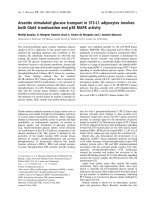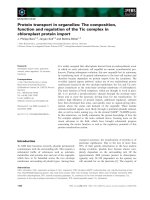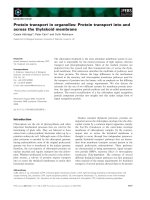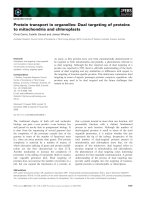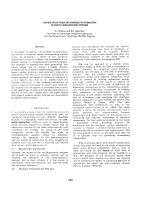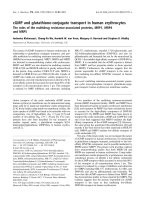Thermal transport in low dimensional graded structures and silicon nanowires
Bạn đang xem bản rút gọn của tài liệu. Xem và tải ngay bản đầy đủ của tài liệu tại đây (4.17 MB, 125 trang )
THERMAL TRANSPORT IN
LOW DIMENSIONAL GRADED STRUCTURES AND
SILICON NANOWIRES
YANG NUO
NATIONAL UNIVERSITY OF SINGAPORE
2010
THERMAL TRANSPORT IN
LOW DIMENSIONAL GRADED STRUCTURES
AND SILICON NANOWIRES
YANG NUO
B.S. (UNIVERSITY OF SCIENCE AND TECHNOLOGY OF CHINA) 2000
M.ENG. (CHINESE ACADEMY OF SCIENCE) 2003
A THESIS SUBMITTED
FOR THE DEGREE OF DOCTOR OF PHILOSOPHY
DEPARTMENT OF PHYSICS
NATIONAL UNIVERSITY OF SINGAPORE
2010
ii
c
⃝
Copyright by
YANG NUO
2010
All Rights Reserved
i
Acknowledgements
I was extremely fortunate for the opportunity to work with, learn from,
and establish friendships with some of the finest people during my time in
Singapore.First and foremost, I would like to thank my advisor, Professor LI
Baowen for his support, energy, encouragement, and insightful advice over the
past years. There would be no this research work without his far-sight and
guidance.
I would also like to thank my collaborators, Prof. ZHANG Gang, Prof. WANG
Lei and Dr. LI Nianbei for their sagacity and hard working. Additionally, I
am appreciative of the colleagues in our group, Prof. WANG Wenge, Dr. YAN
Yonghong, Dr. LAN Jinghua, Dr. Tang Yunfei, Mr. LO Wei-Chung and Mr.
ZHANG Lifa for their valuable suggestions and comments.
I am also grateful to all my friends in Singapore.A partial list includes: LI
Pinghui, DAI Liang, LUO Jie, LI Zhipeng, SUI Yi, CHAI Bo, BAI Huixing,
ZHAO Wei, LI Yangfan, LIU Furong, CHEN Xiaobing, ZHENG Jianguo, and
ZHOU Lihong. I really enjoy the frisbee games under the sunset at West Coast
Park.
Finally, I would like to thank my parents and my parents-in-law. I am for-
ever indebted for their love, support, and encouragement. Also, I am greatly
appreciative of my dear wife Ying’s support and never-ending patience with
me.
Abstract ii
Abstract
Very recently, phononic (thermal) devices have been brought forward the-
oretically, in which the phonon is used as information carrier. It drives us to
search materials fit for thermal devices, such as thermal diodes and thermal
transistors. On the first part of this thesis, it is proposed that low dimensional
graded materials are good candidates for thermal rectifier. The heat flux in
the one dimensional harmonic/anharmonic chain with a mass gradient and
the carbon nanocone were studied by using classical non-equilibrium molecu-
lar dynamics simulation. It was found that the heat flowed with asymmetric
in anharmonic lattices with a mass gradient. Moreover, in a certain tempera-
ture region, negative differential thermal resistance was observed. It was also
demonstrated that the structural asymmetry in carbon nanocone benefited the
rectification ratio remarkably. It was found that there was a larger heat flux in
the direction of decreasing diameter and the rectification in carbon nanocone
was size independent. Possible applications in constructing thermal rectifiers
and thermal transistors by using the graded material were discussed.
The silicon nanowire (SiNW) has been shown to be an efficient thermo-
electric material. The thermal conductivity of SiNW is crucial in thermo-
electric applications. On the second part of this thesis, using classical non-
equilibrium molecular dynamics simulation, it was studied that the reduc-
tion of the thermal conductivity of SiNWs with two isotope-doping methods:
doping nanowires with isotope impurities randomly and isotopic-superlattice
nanowires. It was shown that these two methods led to a large scale de-
crease of thermal conductivity of SiNWs. The thermal conductivity of isotopic-
superlattice structured SiNWs depended clearly on the period length of super-
Abstract iii
lattice. The mass effect on thermal conductivity was obvious. The heavier iso-
tope atoms (
42
Si) could decrease the conductivity much more than the lighter
ones (
29
Si). The remarkable isotopic effect observed in this work provides an
efficient approach to decrease thermal conductivity of SiNW, which could be
of great benefit to improve the thermoelectric performance. These improve-
ments have raised the exciting prospect that SiNWs can be applied as novel
nano-scale thermoelectric materials. It was also studied that the size effect
on the thermal conductivity of nanowire structures. It was demonstrated that
the thermal conductivity of SiNWs diverged with the longitudinal length, even
when the sample length was much longer than the phonon mean free path at
the room temperature, which meant Fourier’s empirical law was broken. The
effect of fixed boundary on heat transport in SiNW was researched. It was re-
ported that there was obvious difference between the heat flux of atoms close
to boundary and the flux of atoms at the center of cross section.
Contents
Acknowledgements i
Abstract ii
Contents iv
List of Tables viii
List of Figures ix
1 Introduction 1
1.1 Thermal Transport in Low-Dimensional Systems . . . . . . . . . 3
1.1.1 Thermal Transport in 1D Chains . . . . . . . . . . . . . 3
1.1.2 Thermal Transport in Quasi-1D Nano-Structures . . . . 5
iv
CONTENTS v
1.1.3 1D Thermal Management Device Models . . . . . . . . 8
1.2 Potential of Using Silicon Nanowires in Thermo electrics . . . . . 10
1.2.1 Thermoelectric Effects . . . . . . . . . . . . . . . . . . 10
1.2.2 Low Dimensional Thermoelectric Materials . . . . . . . 12
1.3 Molecular Dynamics Simulation . . . . . . . . . . . . . . . . . . 15
1.3.1 Methods . . . . . . . . . . . . . . . . . . . . . . . . . . . 16
1.3.2 Thermodynamic Properties . . . . . . . . . . . . . . . . 19
1.4 Objectives . . . . . . . . . . . . . . . . . . . . . . . . . . . . . . 26
2 Thermal Rectification Effects in Low Dimensional Graded Struc-
tures 27
2.1 Thermal Rectification in 1D Mass-Graded Lattice . . . . . . . . 28
2.1.1 Simulation Method . . . . . . . . . . . . . . . . . . . . . 29
2.1.2 Abnormal Thermal Conductivity in Graded Harmonic
Lattice . . . . . . . . . . . . . . . . . . . . . . . . . . . . 30
2.1.3 Abnormal Thermal Conductivity Graded Anharmonic
Lattice . . . . . . . . . . . . . . . . . . . . . . . . . . . . 33
2.1.4 Thermal Rectification in Graded Anharmonic Lattice . . 35
CONTENTS vi
2.1.5 Negative Differential Thermal Resistance . . . . . . . . . 38
2.1.6 Rectification Mechanism in 1D Graded Chain . . . . . . 38
2.2 Thermal Rectification in Carbon Nanocone . . . . . . . . . . . . 41
2.2.1 Simulation Method . . . . . . . . . . . . . . . . . . . . . 43
2.2.2 Thermal Rectification in Carbon Nanocone . . . . . . . . 45
2.2.3 Heat Bath, Temperature and Size Effect and NDTR . . . 49
2.2.4 Rectification Mechanism in Carbon Nano cone . . . . . . 53
2.3 Summary . . . . . . . . . . . . . . . . . . . . . . . . . . . . . . 56
3 Thermal Conductivity of Silicon Nanowires 58
3.1 Background . . . . . . . . . . . . . . . . . . . . . . . . . . . . . 58
3.2 Thermal Conductivity of Isotope Doped Silicon Nanowires . . . 61
3.2.1 Modeling Method . . . . . . . . . . . . . . . . . . . . . . 61
3.2.2 Thermal Conductivity of Random Doping Silicon Nanowires 63
3.2.3 Thermal Conductivity of Superlattice Structure Silicon
Nanowires . . . . . . . . . . . . . . . . . . . . . . . . . . 70
3.3 Size Effect on Thermal Conductivity of Silicon Nanowires . . . . 75
CONTENTS vii
3.3.1 Modeling Method . . . . . . . . . . . . . . . . . . . . . . 76
3.3.2 Dependence of Thermal Conductivity on Longitudinal
Length . . . . . . . . . . . . . . . . . . . . . . . . . . . . 78
3.4 Boundary Effect on Thermal Conductivity . . . . . . . . . . . . 83
3.5 Summary . . . . . . . . . . . . . . . . . . . . . . . . . . . . . . 85
4 Conclusions and Future Works 89
Publication list 111
List of Tables
2.1 The relationship between the flux rectification and the overlap
of phonon power spectra. . . . . . . . . . . . . . . . . . . . . . . 55
3.1 Thermal conductivity of SiNWs with two kinds of randomly
doping isotope atoms. . . . . . . . . . . . . . . . . . . . . . . . . 69
viii
List of Figures
1.1 Schematic 1D chain . . . . . . . . . . . . . . . . . . . . . . . . . 22
2.1 Schematic picture of the mass graded lattice . . . . . . . . . . . 29
2.2 Temperature profiles for the graded lattice . . . . . . . . . . . . 31
2.3 The heat conductivity of the graded harmonic lattice κ versus
system size N . . . . . . . . . . . . . . . . . . . . . . . . . . . 32
2.4 The heat conductivity of the graded FPU lattice κ versus system
size N . . . . . . . . . . . . . . . . . . . . . . . . . . . . . . . . 34
2.5 Thermal rectification in the graded FPU lattice . . . . . . . . . 37
2.6 NDTR in the graded FPU lattice . . . . . . . . . . . . . . . . . 39
2.7 Phonon spectra in graded FPU lattice . . . . . . . . . . . . . . 40
2.8 Schematic picture of the carbon nano cone. . . . . . . . . . . . . 42
2.9 Thermal rectification of nanocone. . . . . . . . . . . . . . . . . . 47
2.10 Temperature profile of nano cone. . . . . . . . . . . . . . . . . . 48
2.11 Contact effect and temperature dependence of thermal rectifi-
cation of nanocone. . . . . . . . . . . . . . . . . . . . . . . . . . 50
2.12 Size independence of thermal rectification of nanocone. . . . . . 51
2.13 NDTR in carbon nanocone. . . . . . . . . . . . . . . . . . . . . 53
2.14 Power spectra of atoms in nanocone. . . . . . . . . . . . . . . . 54
ix
LIST OF FIGURES x
3.1 Schematic picture of the SiNW. . . . . . . . . . . . . . . . . . . 61
3.2 Quantum correction to the MD temperature of the SiNW. . . . 62
3.3 Temperature profiles of SiNWs with different percentage of ran-
domly doping isotope atoms . . . . . . . . . . . . . . . . . . . . 64
3.4 Thermal conductivity of SiNWs versus the concentration of ran-
domly doping isotope atoms . . . . . . . . . . . . . . . . . . . . 65
3.5 Fitting curve of thermal conductivity of SiNWs versus the con-
centration of randomly doping isotope atoms . . . . . . . . . . . 68
3.6 Schematic picture of the isotopic-superlattice structured SiNW. 70
3.7 Temperature profiles of isotopic-superlattice SiNWs. . . . . . . . 72
3.8 Thermal conductivity of superlattice SiNWs versus the period
length . . . . . . . . . . . . . . . . . . . . . . . . . . . . . . . . 73
3.9 Phonon density of states spectra in isotopic-superlattice nanowire
structures . . . . . . . . . . . . . . . . . . . . . . . . . . . . . . 74
3.10 Temperature profiles of SiNWs . . . . . . . . . . . . . . . . . . . 77
3.11 The dependence of thermal conductivity of SiNWs on the lon-
gitude length at room temperature. . . . . . . . . . . . . . . . . 81
3.12 The behavior of energy diffusion in SiNWs. . . . . . . . . . . . . 82
3.13 The effect of fixed boundary on heat flux of atoms in SiNWs. . . 84
3.14 The cross section of SiNWs. . . . . . . . . . . . . . . . . . . . . 84
3.15 The phonon density of states spectra of central atoms and atoms
closest to the fixed boundary. . . . . . . . . . . . . . . . . . . . 86
3.16 The velocity autocorrelation function of central atoms and atoms
closest to the fixed boundary. . . . . . . . . . . . . . . . . . . . 87
Chapter 1
Introduction
In recent years, the advances in synthesis processing and microanalysis have
made it possible to manufacture materials with the length scale of several
nanometers. The nano-materials are generally defined as the materials whose
scales are close to 1 to 100 nanometers, such as two-dimensional (2D) super-
lattices, one-dimensional (1D) nanowires and nanotubes, and zero-dimensional
(0D) quantum dots. The nano-materials have attracted considerable attention
in the past years because of their theoretical significance and potential wide
industrial applications in nano-scale electronic, optoelectronic, photonic, and
energy conversion devices. For example, in terms of worldwide sales, the most
important devices are the integrated chips used in computer circuits and mem-
ories. Device engineers are astonishingly clever at maintaining Moore’s Law,
which states that the size of individual device components gets smaller as one
half approximately every two years. It is predicted that the silicon-on-insulator
transistors will reach a gate length of 18 nm by the year 2010 [1]. The reason
we are interested in the nano-materials is that the size really matters when
it reaches the nanometer region and the surface/interface effect cannot be ne-
glected anymore, which makes the properties of nano-materials much more
1
2
different from their bulk counterparts.
In view of the current and envisioned applications of nano-materials, ther-
mal management is a serious issue. Understanding and predicting thermal
transport at nano-scales is essential to further the advance of the nano-industry.
Here we focus on the thermal transport in semiconductor nano-systems, where
the heat is mainly transferred by phonons, the quantized lattice vibrations,
and the contributions from electrons can be neglected.
Phonons have a wide variation in frequency, and an even larger variation
in their mean-free-paths (MFPs). In the bulk, the heat is often carried by
phonons of large wave vector, and their MFPs are at the order 100 nm at
room temperature, for example, a detailed study by Ju and Goodson shows
MFPs of phonons that carry heat in silicon at room temperature are around
300 nm [2]. So in the nano-materials of current interest, the scale of the
structure is the same scale as MFPs of phonons, and sometimes comparable
to the phonon wavelength (∼ 1 nm) [3]. The phonon scattering at boundary
or interface can limit MFPs and decrease the thermal conductivity. At this
scale, the phonon group velocity and density of states may also be modified.
The low thermal conductivity in 2D and 1D nano-materials are reported [2,4].
This is good for some applications of nano-materials, where one wants the
thermal conductivity to be as small as possible, such as thermal barriers or
thermoelectric materials used for solid-state refrigeration.
The understanding of heat transport in nanoscale is definitely necessary.
So far, no analytical theories have adequately treated the wave nature of
phonons at the length scale of nanometers. In the following search, the ther-
1.1. Thermal Transport in Low-Dimensional Systems 3
mal transport in bulk and nano-structures are introduced firstly. Secondly, the
application of nano-material in thermoelectrics is shown. At the end of this
chapter, molecular dynamics simulation methods and research objectives are
presented.
1.1 Thermal Transport in Low-Dimensional Sys-
tems
1.1.1 Thermal Transport in 1D Chains
Fourier’s law, also known as the law of heat conduction, states that the time
rate of heat flowing through a homogenous material is proportional to the area
of the section at the right angle, to the direction of heat flow, A, and to the
temperature gradient along the path of heat flow, ∇T , as
dQ/dt = −κA∇T, (1.1)
where κ is thermal conductivity. Fourier’s law means a normal conduction in
system, where thermal conductivity is independent of system size.
Fourier’s law is broken in the harmonic system, which is well studied.
Rieder et al. showed the analytic solution to the heat conductivity in harmonic
lattice [5]. They proved that the thermal conductivity is linearly proportional
to the length of lattice as:
κ ∝ L. (1.2)
It is also known as ballistic heat conductivity. Another property of harmonic
system is that the temperature profile can not be built along harmonic chain,
which means there is no energy diffusion and mode coupling.
1.1. Thermal Transport in Low-Dimensional Systems 4
In the last few decades, there are many studies on the heat conduction in
1D lattices. It was found that there was an abnormal conduction in a chain
with nonlinear potential and the Fourier’s law was violated [5–14, 16–18]. It
was found that thermal conductivity of FPU-like chains diverged with the
system size L, as κ ∝ L
β
. The results reported β varied from 0.33 to 0.44 [8,
11–14,16,17]. There was much debating on searching for a universal exponent
value of β. In 2002, Narayan and Ramaswamy asserted β should be 1/3 in 1D
momentum-conserving systems by a renormalization group approach of the
hydrodynamic equation of heat transport in a liquid [13]. In the following
year, using mode-coupling theory, Levi, Livi and Politi derived the universal
exponent β = 2/5 [12, 14]. Wang and Li found that β equaled 2/5 at low
temperature and weak coupling in 1D lattice and β was 1/3 when there was
coupling between longitudinal and transverse modes [16].
The sufficient condition for keeping Fourier’s law in low dimensional system
is still an open question. Generally, studies have been focusing on disorders,
chaos and the breaking of momentum conservation.
Zhao et al. reported that the boundary condition was dominant in the
divergence of thermal conductivity in chains with random masses or coupling
constants and momentum conservation was a key factor of the anomalous heat
conduction. The thermal conductivity diverged as κ ∝ L
1/2
with free boundary
condition, and converged as κ ∝ L
−1/2
with fixed boundary condition [6].
In 1984, within the ding-a-ling model, Casati et al. found there was nor-
mal heat conductivity when system was in chaotic regime and anomalous con-
ductivity in regular regime [7]. However, Lepri et al. found the anomalous
1.1. Thermal Transport in Low-Dimensional Systems 5
thermal conductivity in Fermi-Pasta-Ulam (FPU) -β chain, which had posi-
tive Lyapunov exponent and was chaotic [8]. Later, Li et al. showed that chaos
was not even a necessary condition for normal thermal conductivity by finding
finite thermal conductivity in 1D models with zero Lyapunov exponents [19].
The breaking of momentum conservation was proposed as the candidate
for the cause of normal thermal conductivity. It was shown that the heat
conductivity obeyed the Fourier law in the Frenkel-Kontorova (FK) lattice [20]
and ϕ
4
lattice [21] where the momenta were not conserved because of the on-
site potential. However, the breaking of momentum conservation was not the
necessary condition of normal thermal conductivity, because it was found that
the heat conductivity was size independent in a system without the breaking
of momentum conservation, the 1D coupled rotor model [22,23]. On the other
hand, it was proposed that the momentum conservation was the sufficient
condition for divergent thermal conductivity [9].
1.1.2 Thermal Transport in Quasi-1D Nano-Structures
Recently, many researches focus on the thermal transport in quasi-1D materi-
als, like silicon nanowires and carbon nanotubes. The new thermal properties
in nano-materials are still not clearly understood.
In 2000, Berber et al. predicted the super high thermal conductivity of an
isolated (10, 10) single wall carbon nanotubes (SWCNT), 6600 W/mK at room
temperature, by using classical molecular dynamics (MD) methods [34]. This
is a significant result, which motivated huge interest on researching thermal
1.1. Thermal Transport in Low-Dimensional Systems 6
property of CNT for its potential applications. Later, Kim et al. showed ex-
perimentally the high conductivity of multi-wall carbon nanotubes(MWCNs),
more than 3000 W/mK at ro om temperature [36]. The ultra-high conduc-
tivity would come from the pure honeycomb structure of carbon nanotubes
and large mean free path of phonons in nanotubes. However, recent reports
showed that the value of thermal conductivity were much lower. Experimen-
tally, Yang et al. measured thermal conductivities of MWCNs, where the
length of MWNTs ranged from 10 to 50 µm and the diameter was from 40 to
100 nm [35]. The value of thermal conductivities were around 200 W/mK. In
2003, it was shown that thermal conductivities (10,10) increased from 270 to
390 W/mK when lengths varied from 10 to 200 nm for 300 K by Maruyama
using MD simulation [39]. In 2004, Padgett and Brenner reported that ther-
mal conductivities of isolated (10,10) pristine CNTs at room temperature was
around 350 W/mK also by classical MD simulation, where the value of con-
ductivity was independent of length after the length exceeding 0.15 µm [37].
In the same year, Moreland, Freund, and Chen obtained thermal conductiv-
ities of SWCNT (10,10) varied from 215 W/mK (for a 50 nm periodic box
length) to 831 W/mK (for a 1 µm box) at ro om temperature by classical MD
simulation [38].
Lately, there were some studies discussing the size dependence character
in nanotubes, which is an important character of thermal transport in low
dimensional system. That is, the Fourier’s Law would be broken down in
nanotubes. In 2002, Maruyama asserted that the conductivity of SWCNT
(5,5) diverged with the length as κ ∝ L
0.32
and the conductivity of SWCNT
(10,10) was not dependent on the length by MD simulations [40]. However, one
1.1. Thermal Transport in Low-Dimensional Systems 7
year later, Maruyama reported that all thermal conductivities of SWCNT (5,5)
(8,8) and(10,10) diverged as L
β
, where β were 0.27, 0.15 and 0.11 respectively
[39]. In 2005, Zhang and Li showed the conductivity of both SWCNT (5,5)
and (10,10) diverge with the length as κ ∝ L
β
, where β depended on the
temperature, by MD simulations too [41]. Experimentally, Chang et al. found
that the conductivity of multi-wall carbon nanotubes diverged with the length,
and β was from 0.6 to 0.9 at room temperature [42]. Different conclusions come
from different groups, so the dependence of thermal conductivity on length of
nanotube is still an open question.
There are also some studies on thermal properties of the silicon nanowires
(SiNWs), another important member in nano-structure family. In the contrast
to the high thermal conductivity of CNTs, Volz and Chen predicted the ultra-
low thermal conductivity of SiNWs, which was about two orders of magnitude
smaller than the thermal conductivity of bulk Si crystals by MD simulations
[43]. They solved the Boltzmann transport equation to explain the possibility
of diffuse boundary scattering causing the thermal conductivity drop, which
was observed in the MD simulation. A few years later, Li et al. showed
experimentally the ultra-low thermal conductivity of single SiNW [4]. The
ultra-low thermal conductivity of SiNW could be mainly caused by two factors.
First, the confinement of size lessens the number of phonon mo des in the
system. Second, the boundary dispersion of phonons decreases the mean free
path of phonons. These findings make a significant progress on applications
of SiNWs. For example, SiNWs can be used in thermoelectric system which
needs ultra-low thermal conductivity materials.
There are some studies which paid attention to the dependence of conduc-
1.1. Thermal Transport in Low-Dimensional Systems 8
tivity on the size of SiNW. In 2006, Liang and Li studied the radius dependence
of thermal conductivity in nano-scale semiconducting systems [138]. They de-
rived an analytical formula of thermal conductivity of nano-structures, which
included the surface scattering and the size confinement effects of phonon
transport, as
κ
D
κ
bulk
= p · exp(−
l
0
D
)[exp(
1 − α
D/L
0
− 1
)]
3/2
, (1.3)
where D was the size of nano-structure, such as the diameter of nanowire or the
thickness of thin film, κ
D
was the thermal conductivity of this nano-structure
with size D, κ
bulk
the thermal conductivity of bulk, p a parameter of roughness,
l
0
the phonon mean free path, α ≡ σ
2
sur
/σ
2
in
a material constant corresponding
to the mean square deviation of surface atoms of a crystal and that of atoms
within the crystal, L
0
a critical size at which almost all atoms of a crystal are
located on its surface. The data predicted by the analytical formula were in
good agreement with experimental data for Si and GaAs nanowires and thin
films.
1.1.3 1D Thermal Management Device Models
The information technology, based on the transistor and other electronic de-
vices, changed many aspects of our lives. In nature, besides electrons and
photons, phonons can also transport energy. However, phononic devices are
still not available, because it is much harder to control the flow of phonons in
a solid than it is to control the flow of electrons. In recent years more atten-
tion has been directed toward the phonon management on energy transp ort in
dynamical systems and the emerging field is described as phononics. Ther-
mal diodes, thermal transistors and thermal logic gates, which are the basic
1.1. Thermal Transport in Low-Dimensional Systems 9
components of functional thermal devices, have recently been proposed in the-
oretical model by researchers. Previously, the heat is regarded as useless or
harmful in electronic circuits. The emerging of phononics raises the possibility
that heat could be used to process information. In addition to electrons and
photons, phonons would therefore transfer information.
In 2002, a prototypes of solid state thermal diode was proposed by Ter-
raneo, Peyrard, and Casati using 1D chain with Morse on-site potential [24].
Only the plane wave whose frequency is included in the phonon band can
transfer to the system. The thermal rectification effect could be explained
from the matching/mismathcing of phonon bands.
Later, Li, Wang, and Casati realized a very significant rectifying effect
by two-segment Frenkel-Kontorova (FK) model and demonstrated that this
thermal diode model could work in a wide range of system parameters [25].
They showed that the position of phonon band moved with the change of
temperature, which is due to the nonlinearity of the potential. And it was the
temperature dependence of the phonon band that made the rectifying effect
possible. Therefore, the rectifying effect should be observed in any nonlinear
lattice. Based on experiences on the previous successful model, Li, Lan and
Wang proposed a new thermal diode model which connected one segment
with FK on-site potential to another segment without on-site potential, in
2005 [26]. They found that the ratio of the thermal resistance in one direction
to the thermal resistance in the opposite direction could be achieved close to
one thousand.
In 2005, Segal and Nitzan reported the asymmetric heat conduction in
1.2. Potential of Using Silicon Nanowires in Thermo electrics 10
a simple anharmonic system, a spin-boson nanojunction model, where the
couplings to the heat reservoirs were different [27]. Hu, Yang, and Zhang
showed a reversal of the rectification effect in the two-segment FK model in
2006 [30].
However, the segments with on-site potential could be difficult to achieve
experimentally, and the on-site potential would introduce a new channel for
thermal energy transport which would reduce the efficiency of the rectifier.
Besides thermal diode, there are also some reports on other thermal de-
vices. In 2006, Li, Wang and Casati found the negative differential ther-
mal resistance in nonlinear lattices, which provided the possibility of building
the thermal transistor by a three-segment FK device [29]. In the following
year, Wang and Li realized a thermal logic gate model based on nonlinear lat-
tices [31]. Computations could be operated not only with electrons but also
with phonons. In 2008, Wang and Li brought forward the model of heat mem-
ory. The heat memory could be durable and could be read without destroying
the information. Rather than electric charges, the heat memory was based on
quantum packets of heat [32].
1.2 Potential of Using Silicon Nanowires in
Thermoelectrics
1.2.1 Thermoelectric Effects
Traditionally, thermoelectric effect or thermoelectricity encompasses three sep-
arately identified effects, the Seebeck effect, the Peltier effect, and the Thomson
1.2. Potential of Using Silicon Nanowires in Thermo electrics 11
effect.
Back in 1823, Thomas Seebeck first observed that a temperature gradient
across a sample created a voltage drop between the hot and cold ends, which
was the so-called thermoelectric effects. A Seebeck coefficient S is named after
him as:
S
ab
= dT/dV, (1.4)
where S
ab
is the relative Seebeck coefficient between materials a and b, V is
the voltage drop and T is temperature. Seebeck coefficient describes the ther-
moelectric voltage change rate with respect to temperature. Thermoelectric
effects provide the principle for thermocouples used to measure temperature
difference and for thermoelectric power generators. A complementary effect
was observed by Peltier in 1835. He observed temperature changes at the junc-
tions between two dissimilar conductors through which a current was passed.
This effect is now called Peltier effect.The Peltier coefficient between materials
a and b, is defined as
Π
ab
= Q/I, (1.5)
where Q is the heat flow rate at the junctions and I is the current. In 1851,
the Thomson effect was predicted and subsequently experimentally observed
by William Thomson (Lord Kelvin), which established a relationship between
the Seebeck and Peltier coefficients as:
Π
ab
= S
ab
T. (1.6)
The Thomson effect describes the heating or cooling of a single homogeneous
conductor when a current is passed through the material in the presence of a
fixed temperature gradient.
1.2. Potential of Using Silicon Nanowires in Thermo electrics 12
The efficiency of thermoelectric materials depends on material properties
through the dimensionless parameter ZT , called the figure of merit [52]:
ZT =
σT S
2
κ
, (1.7)
where S, T, σ, and κ are the Seebeck coefficient, absolute temperature, elec-
tronic conductivity and total thermal conductivity, respectively.
In the 1950’s, Abram Ioffe found that the ZT of heavily doped semicon-
ductors was bigger that other materials, which arouse a frenzy of research in
looking for semiconducting material fit for thermoelectric element. So, the
initial interest in semiconductors and semiconductor physics was driven by
thermoelectric refrigeration, instead of microelectronics. Till now, the best
thermoelectric materials were found to be Bi
2
T e
3
/Sb
2
T e
3
alloys, whose value
of ZT is around unity [47]. Thermoelectric coolers with a ZT = 1 operate at
only about 10% of Carnot efficiency. Being comparable to vapor compression
refrigerators, coolers could operate at 30% of Carnot efficiency, where ZT needs
to be improved to four [48]. In spite of the low efficiency, the thermoelectric
refrigerator is silent, reliable, lightweight, and environment friendly. What’s
more attractive is that thermoelectrics can generate electric p ower from waste
heat.
1.2.2 Low Dimensional Thermoelectric Materials
In the early 1990s, the interests of U.S. Department of Defense in the potential
application of thermoelectrics stimulated the research in thermoelectric mate-
rials. It was found that low dimensional materials were suitable candidates for

